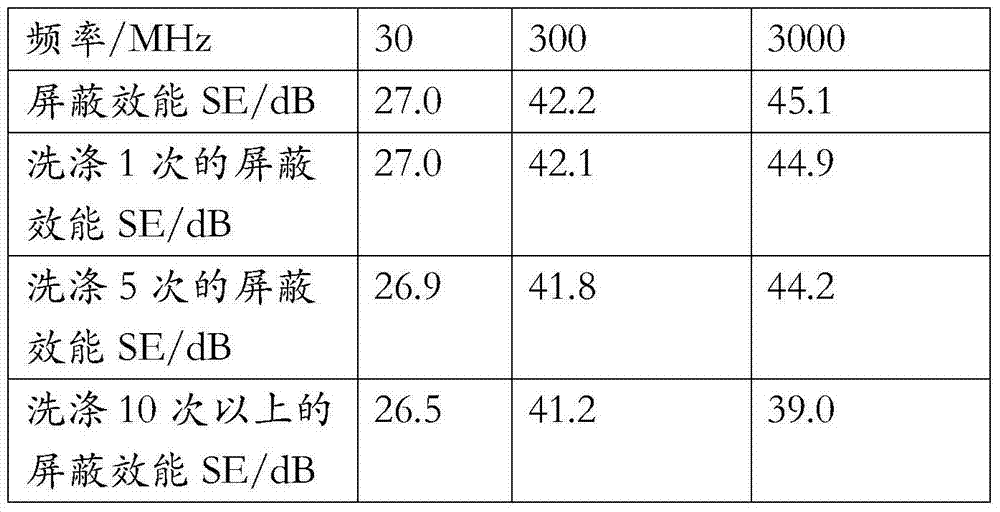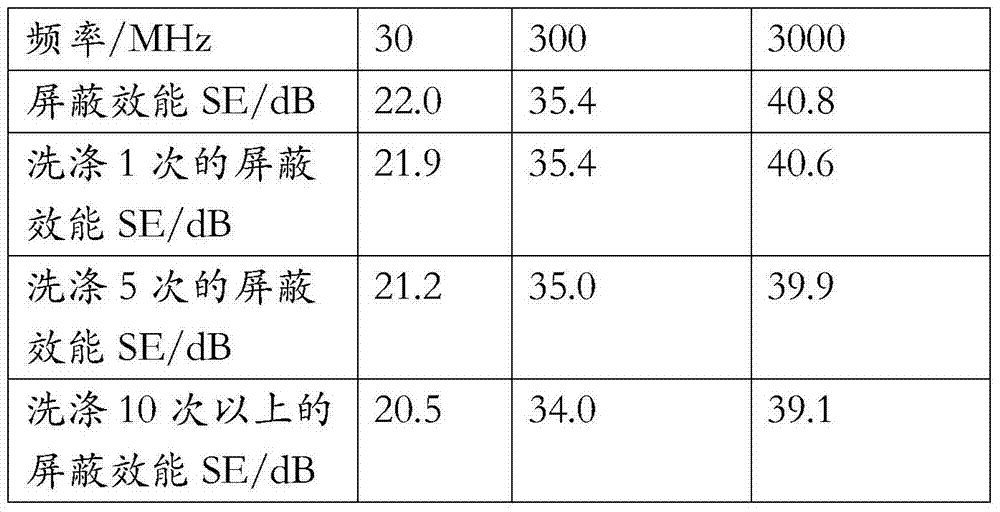Anti-radiation finishing processing method for fabric
A processing method and anti-radiation technology, which is applied in the processing of textile materials, liquid/gas/steam textile material processing, fiber processing, etc., can solve the problems of metal fiber processing and use limitations, inapplicability, etc., and achieve good washing resistance , excellent cushioning, and excellent radiation resistance
- Summary
- Abstract
- Description
- Claims
- Application Information
AI Technical Summary
Problems solved by technology
Method used
Image
Examples
Embodiment 1 1
[0045] Embodiment one, 1# fabric
[0046] 1. Preparation of materials
[0047] (1) Fabric: 26s TK / 1 jersey
[0048] (2) Nano-magnetic metal absorber: self-made nano-magnetic metal particles 1#
[0049] The preparation method of nano magnetic metal particles 1#: add 2g FeCl to 500mL 2 and 5gFeCl 3 , after fully dissolved, add NaOH solution dropwise at a constant speed under the action of a stirring bar, and when the pH value rises to 6-7, Fe will be generated 3 o 4 , filter the resulting precipitate, dry it, and finally make it into nanoparticles with an ultrasonic pulverizer.
[0050] (3) Polymer adhesive: Polyurethane adhesive LF-85 (Shanghai Lifeng Chemical Technology Co., Ltd.).
[0051] 2. Anti-radiation finishing process
[0052] The anti-radiation finishing process adopts the padding and baking process, and the fabric is dried and baked after padding the finishing solution, so that the nano-magnetic metal is attached to the fabric.
[0053] (1) Composition of wor...
Embodiment 2 2
[0064] Embodiment two, 2# fabric:
[0065] 1. Preparation of materials
[0066] (1) Fabric: T / C50 / 50 polyester cotton jersey
[0067] (2) Nano-magnetic metal absorber: self-made nano-magnetic metal particles 1#
[0068] (3) Polymer adhesive: Polyurethane low-temperature adhesive (Shanghai Textile Research Institute)
[0069] 2. Anti-radiation finishing process
[0070] The anti-radiation finishing process adopts the padding and baking process, and the fabric is dried and baked after padding the finishing solution, so that the nano-magnetic metal is attached to the fabric.
[0071] (1) Composition of working fluid:
[0072] Nano magnetic metal wave absorber 60g / L
[0073] Polymer binder 60g / L
[0074] (2) Radiation protection finishing process curve
[0075] The fabric is dipped and rolled twice in the working solution → drying (90°C, 3min) → baking (140°C, 2min) → cooling
[0076] 3. Radiation protection performance test
[0077] According to GB / T23463-2009 "Protectiv...
Embodiment 3
[0082] Embodiment three, 3# fabric
[0083] 1. Preparation of materials
[0084] (1) Fabric: 150D pure polyester double-sided cloth
[0085] (2) Nano-magnetic metal absorber: self-made nano-magnetic metal particles 1#
[0086] (3) Polymer adhesive: Polyurethane adhesive Bilibai PU NEW (BASF).
[0087] 2. Anti-radiation finishing process
[0088] The anti-radiation finishing process adopts the padding and baking process, and the fabric is dried and baked after padding the finishing solution, so that the nano-magnetic metal is attached to the fabric.
[0089] (1) Composition of working fluid:
[0090] Nano magnetic metal absorber 30g / L
[0091] Polymer binder 40g / L
[0092] (2) Radiation protection finishing process curve
[0093] The fabric is dipped and rolled twice in the working solution → drying (90°C, 3min) → baking (145°C, 2min) → cooling
[0094] 3. Radiation protection performance test
[0095] According to GB / T23463-2009 "Protective Clothing Microwave Radiatio...
PUM
 Login to View More
Login to View More Abstract
Description
Claims
Application Information
 Login to View More
Login to View More - R&D
- Intellectual Property
- Life Sciences
- Materials
- Tech Scout
- Unparalleled Data Quality
- Higher Quality Content
- 60% Fewer Hallucinations
Browse by: Latest US Patents, China's latest patents, Technical Efficacy Thesaurus, Application Domain, Technology Topic, Popular Technical Reports.
© 2025 PatSnap. All rights reserved.Legal|Privacy policy|Modern Slavery Act Transparency Statement|Sitemap|About US| Contact US: help@patsnap.com



